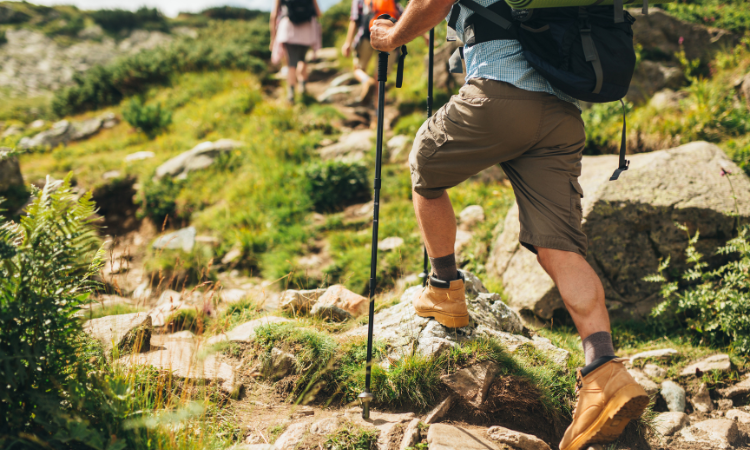Hiking is an outdoor activity that has gained popularity in recent years, attracting people of all ages who seek a closer connection with nature and an escape from the hustle and bustle of everyday life. Rather than just a simple walk, hiking offers an opportunity to explore the natural world in a deep and meaningful way.
At Arandovo, we want to bring you closer to the whole world of hiking, that’s why we have prepared this post in which we’ll tell you what hiking is, what it consists of, its benefits, and how you can start practicing it. Mind joining us?

What is hiking?
Hiking is an activity that consists of walking along trails, paths, or routes in natural environments; generally, in mountains, forests, fields or nature reserves.
Unlike more extreme activities such as mountaineering, hiking is a practice accessible to people of all ages and fitness levels. The main characteristic of hiking is that it does not require specialized equipment, beyond good footwear and appropriate clothing.
The term “hiking” comes from the word “trail”, which refers to paths or routes designed for walking. These trails can vary in difficulty, from leisurely strolls on flat terrain to more challenging routes that require steep ascents and technical descents. The beauty of hiking lies in its flexibility; there is a suitable route for everyone, regardless of experience or skills.
What does hiking consist of?
Hiking involves more than just walking. It is a complete experience that combines physical activity, exploration, and connection with nature. Hikers can enjoy a variety of landscapes, from lush forests to mountain peaks with panoramic views. In addition, hiking can be a solitary activity or a social experience, depending on whether you prefer to hike alone or in a group.
Before starting a hike, it is important to be prepared. This includes carrying the right equipment, such as comfortable, sturdy shoes, appropriate clothing for the weather, water, light food, and a map or GPS device. It is also important to know your physical limits and plan routes that fit your fitness level and experience.
Hiking is not just about walking from point A to point B. It is an opportunity to stop, observe the local flora and fauna, breathe fresh air, and enjoy the silence of nature. Each step brings you closer to a richer and more rewarding experience, allowing you to disconnect from daily stress and reconnect with the natural world.
What is the purpose of hiking?
The main objective of hiking is to enjoy nature while engaging in moderate physical activity. However, the reasons for hiking can vary from person to person. Some seek to improve their health and fitness, others wish to find peace and relaxation in nature, and many see it as a form of adventure and exploration.
Hiking can also be an educational activity. As you explore different environments, you have the opportunity to learn about the local geography, biodiversity, and history of the region. For those interested in photography, hiking offers countless opportunities to capture natural beauty from unique perspectives.
In addition, hiking fosters a sense of personal accomplishment. Completing a route, especially one that presents certain challenges, can boost confidence and provide a sense of satisfaction. Said activity is an excellent way to set and achieve personal goals, which can have a positive impact on other areas of life.
Types of hiking
Hiking can be classified into different types, depending on the environment and conditions in which it is practiced. Hereafter we’ll review some of the most common types of hiking:
Mountain hiking
Mountain hiking involves walking on elevated and often rugged terrain. This type of hiking can be more challenging due to steep ascents and descents, as well as variable weather conditions.
Mountain trails offer spectacular views and the opportunity to reach summits that offer a breathtaking perspective of the surrounding landscape.
Nature hiking
Nature hiking takes place in areas such as national parks, nature reserves, and forests. These routes are usually less demanding than mountain routes, but offer a rich biodiversity and the opportunity to observe wild animals, plants, and unique geological formations.
It is an excellent option for those looking for a quiet and educational experience in nature.
Snow hiking
Snow hiking, also known as winter hiking, is practiced in snowy and cold conditions. This type of hiking requires specialized equipment, such as waterproof boots, crampons, and thermal clothing.
Although it can be more challenging, it offers a unique experience and the chance to explore winter landscapes that few people get to see.
Hiking benefits
Hiking offers a wide range of benefits, both physical and mental. Some of the most prominent include:
Cardiovascular health improvement
Walking at a steady pace and on varied terrain is an excellent form of cardiovascular exercise. It helps to strengthen the heart, reduce blood pressure, and improve blood circulation.
Muscle strengthening
Hiking works a lot of muscle groups, especially in the legs, glutes, and core. Routes with ascents and descents also help improve strength and stability.
Stress reduction
Being in contact with nature has a calming effect on the mind. Hiking helps reduce cortisol levels, the stress hormone, and in turn, promotes relaxation.
Mood improvement
Physical exercise and fresh air contribute to the release of endorphins, improving mood, and can also help fight depression and anxiety.
Social connection
If you decide to hike in a group, it is an excellent opportunity to socialize and strengthen bonds with friends or family. Sharing an experience in nature can create lasting memories and strengthen relationships.
Increase in creativity
Being in nature and away from technological distractions allows the mind to relax and fosters creativity. Many hikers find that the best ideas and solutions to problems emerge during a hike.
Environmental awareness
Hiking fosters a greater appreciation for nature and the importance of preserving natural environments. By spending time in nature, hikers are more likely to develop an ecological conscience and adopt more sustainable practices in their daily lives.
Dietary supplements to prevent injuries and fatigue
At Arandovo, we understand the importance of staying active and connected to nature. That’s why, thanks to our functional ingredient MAKRE®️ you can not only prevent injuries, but also help you stay fit for future hikes.
MKARE®️ is a natural functional ingredient based on eggshell membrane with 100% protein in native state thanks to its 90% membrane purity, which makes it a very complete supplement for your day to day.
In addition, it is rich in elastin, glycosaminoglycans (GAGs), hyaluronic acid, chondroitin sulfate, over 400 proteins, and, of course, collagen type I, V and X with a great regenerating effect, antioxidant and anti-inflammatory power.
Hiking is much more than just a simple walk; it is an opportunity to discover the natural world around us, improve our health and well-being, and find peace and joy in every step we take.
And, in this case, natural dietary supplements can be a valuable complement for those who practice hiking, since this activity, especially on long routes or in demanding terrain, may require a greater supply of energy and nutrients.
So, what are you waiting for? Put on your boots, choose a route and start enjoying the countless benefits that hiking has to offer.




